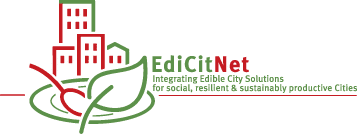Best Overall Edible City Approach
Category
Best Overall Edible City Approach
Type of initiative
City Administration Programme
Location
Oslo, Norway
Our young city farmers not only get to work outside and drive change in public spaces in their part of the city – they also get a bit of money in their pocket.
The EdiCitNet Award for “Best Overall Edible City Approach” is for holistic city-wide initiatives that tackle social challenges and create long-term benefits for the city. In 2021, the winner was the Gamle Oslo District Farmer programme, which has changed young people’s lives by connecting them with urban farming experts and strengthening their relationship to nature.
EdiCitNet talked to Natalie Keene, a district farmer herself, to tell us more about her (dream!) job.
Welcome Natalie, thank you so much for joining us and congratulations. It’s so exciting to see the beautiful photos and images of all the work that you’re doing. Maybe you can tell us in your words a little bit about it. What is it that makes the Gamle Oslo District Farmer initiative so special?
My project has two main parts – one is working with youth, with teenagers and young adults in our district of Oslo and the other one is working with the kindergartens in our district. Oslo has 15 large districts and this one has a lot of people squeezed into a small, but very beautiful place.
There are nearly 60 kindergartens in this district. They can apply to have me or my colleague come and work with them – to expand their outdoor area, plant fruit trees, plants, berry bushes, build kitchen gardens with them and work with them on getting better at being good little gardeners. So I work mostly with the teachers and the staff, so then they can implement that in their day.
And one thing that I really love about the kindergarten project is the worm farms. I love composting and getting to teach teachers and small children how to fall in love with little wriggly worms is fantastic. A lot of them now have worm farms in their classrooms, which is exciting, and a couple of them have really big systems outside that are working really well.
So first, I get to work with the teenagers in our district. Each year our district invests in employing literally hundreds of teenagers and young adults up to the age of 23 years old in our district in green summer jobs. It’s a big step to investing in their basic job training and also giving them a little bit of money in their back pocket to have a great summer.
Three years ago our city council’s environment officer had the idea of creating dozens of green jobs. That’s where I joined the city and that was a pilot project which lasted for three months. I’ve now I’ve been employed full time each year to work on these two big projects. So that’s great.
It sounds like you’re constantly engaged with others and working with them in a really hands-on way. It’s probably not an easy job, but it must be so rewarding as well. Yesterday at the conference, we were talking about how this kind of practical experiences can really bring about a change in people’s attitudes, towards food and nature and their consciousness and their desire to make a change in the future. Have you seen this happen? Do you have any examples of young people becoming inspired to take a new or different path?
It does sound like you are making a difference there in the life of those people, by giving them the wings to fly and take up other challenges. Do you have any words of advice for other cities who would like to set up such a city farmer program, what would that be?
My advice is to other municipality and local governments is that the investment would not be wasted. It’s a fantastic investment in the local community and the teenagers that I get to work with. They have a real opportunity to go into local parks and public spaces to beautify them in a way that is very appealing to them as teenagers. This helps them grow pride in their local community from a young age. And that’s an incredible investment in the population of your city.
Thank you, that’s very inspiring. You said that you’re working closely with the public in public parks. Are you also planting edible plants there? And who’s taking care of them, the students or the municipality?
Yes, my young city farmers and I, literally map our spaces out together and work out where we can grow things and what we have to do to integrate edible plants into those areas. We start to grow a lot of herbs and vegetables in early summer and look after them over the whole summer and into the autumn.
And they’re really popular. The young people make very cute signs saying “Feel free to harvest but please dont take the whole plant!” and we see people passing by, picking them, eating them and enjoying them, right there in public spaces and public parks.

That’s so exciting. I’m sure some of the cities in the EdiCitNet project can learn a lot from that, as they work to plan and implement similar initiatives in public parks. I’m sure we’ll be back in touch to learn more from you in the future! Do you have any final words for us?
Yes. That working with youth within urban agriculture, it isn’t as easy as people would expect. They’re not expert gardeners of course, and some of them when they start the job they’re not even passionate or interested in urban agriculture, they just want a summer job.
So it’s my job to really inspire and motivate them. Just like, RESTLOS GLÜCKLICH in Germany do with their work with the little kids, it’s about finding and communicating those small, fascinating facts that young people find inspiring. That’s our job.
I’ve actually just written a handbook with the help of some colleagues at our district and it’s in Norwegian and now I’m inspired to write it in English and share it through the Edible Cities Network. It should be ready next week. So we’ll work on a translation and send it out.
Thank you, Natalie. Definitely keep us in the mailing list. We would love to see that!
Feeling inspired?
Download the EdiCitNet factsheet on Gamle Oslo District Farmer for more information, photos and contact details.
Check out the other EdiCitNet Awards winners for 2021
Do you want to apply for an EdiCitNet Award? Applications for 2022 are open now!




